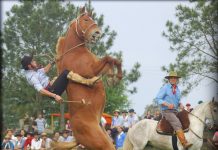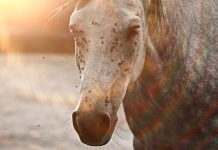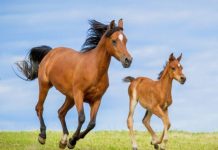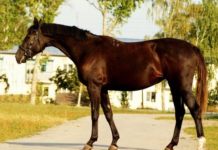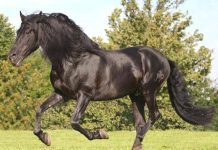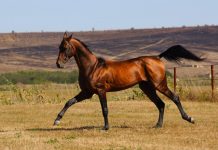The Boulonnais is a cold-blood horse breed that started its “career” as a busy workhorse and, like many cold blood breeds, was almost extinct in the last century.
But since the Boulonnais is a particularly noble and particularly lively draft horse who has fun in many disciplines, he is increasingly being rediscovered as a reliable partner for leisure and work.
Have fun getting to know an extraordinary horse breed where strength and elegance are not mutually exclusive.
Breed description

The Boulonnais is a cold-blooded horse that is considered particularly elegant. A horse straight out of a picture book, which is often allowed to show its beauty as a show horse.
This particular elegance is due to the fact that very noble blood flows in the veins of this cold blood: Both noble Spaniards of the Andalusian type and horses of the early Arab breeding have influenced the genetics of the cold blood in the course of its genesis.
The result was a splendidly formed cold blood, which today is bred in a heavy and a lighter type. And in whose veins not only “cold blood”, but also rather hot blood flows.
The Boulonnais can be used extensively with both types: as a draft horse in front of a carriage, as a leisure horse in many disciplines, as a workhorse in modern, ecological agriculture or forestry.
Size: 150-170 cm
Weight: 600 – 900 kg
Origin: France
Lifespan: 20-25 years
Color: Mold, occasionally foxes and browns
Origin and breed history
The origins of the “Boulonnais” breed lie in the northwest of France, in the provinces of Nord-Pas-de-Calais and Picardie (which were combined to form the Hauts-de-France region in 2016).
The European forest horse Equus ferus silvaticus lived in this area near the Belgian border a long time ago. From this forest horse the ancestors of the French and Belgians, who settled there at that time, bred robust, small utility horses for agriculture, hunting, and warfare.
These horses were the forefathers of our cold-blooded horses, as has been scientifically proven in the meantime. At the same time, the equestrian peoples in the Near East bred the ancestors of our warmblood riding horses from nimble steppe wild horses.
The peoples and their horses met for the first time on a larger scale in the war events of the 12th century (crusades, war expeditions by the peoples of the Near East to the Mediterranean).
The northwest European cold-blooded horses were crossed with the light “thoroughbreds” from the Middle East and with Spanish horses. The foals of these “refined” cold-blooded horses were still quite original cold-blooded horses.
Depending on how the genes mixed, there were also lighter, faster types of riding horses. The first war horses, fairly similar in color and type to the Boulonnais, were mentioned by historians in the 14th century.
For a long time, breeding was quite disorderly, until the Boulonnais began to be bred in a more targeted manner in the 17th century. Two types of Boulonnais were separated: a large, heavy workhorse for agriculture and a smaller, lighter type as a draft horse for supplying the fish markets on the north coast of France.
Since the transport of the draft horses usually began in Boulogne-sur-Mer, the new breed was named after this port city and the surrounding coastal region Boulonnais.
In 1886 the French breeding association “Le Syndicat hippique Boulonnais” was founded to promote the Boulonnais breed and to ensure its preservation. By the beginning of the 20th century, around 160,000 Boulonnais were held in northwestern France.
In 1911, breeding was once again concentrated on a particularly strong and large type of Boulonnais, which was very busy in agriculture and as a transport horse, in front of buses and at work in mines.
After the First World War, the Boulonnais became fewer and fewer because horses were gradually replaced by machines in all areas. By 1950 there were only a few Boulonnais left, which a handful of breeders were trying to save from extinction.
When the Boulonnais were (re) discovered by recreational riders from around the 1970s, the number of Boulonnais and Boulonnais breeders rose again to just over 1000 Boulonnais horses.
In 2003 the Boulonnais Breeding Association was recognized by the French state as the national breed association of France. Since then, the number of Boulonnais in the breeding stock has remained stable, with the number of Boulonnais horses increasing by around 10% annually.
But there are still dramatically fewer Boulonnais, here are a few numbers:
- Between 2013 and 2017, only around 200 Boulonnais foals were born in France each year (2013: 181; 2014: 217; 2015: 192; 2016: 173 and 2017: 167 Boulonnais).
- In 2018, 279 Boulonnais mares were covered, of which statistically only every second admitted, so less than 150 foals are expected.
- From 2013 to 2017 the number of Boulonnais stallions in the breeding farm fell from 41 to 36, most of which are no longer young.
- Everything in France, abroad there is not a single recognized breeding farm.
The beautiful Boulonnais are still among the rarest horse breeds that exist in this world.
The original heart of French breeding in lower Boulonnais has now moved to the northern departments of Nord, Oise, Pas-de-Calais, Seine-Maritime, and Somme.
The appearance of the Boulonnais
All Boulonnais horses share some common characteristics:
- The considerable size between 1.50 m and often more than 1.70 m, recently even more common horses with 180 cm height at the withers.
- A short, elegant head with a well-developed, flat forehead.
- Large, attentive eyes, well-opened mobile nostrils, rather small, very mobile ears.
- The bushy mane is double on either side.
- The body shows a straight back with withers deeply embedded in the well-developed shoulder-back muscles.
- The broad chest with optimally stretched shoulders merges into well-rounded ribs.
- The strong, muscular legs are very stable and show a rather sparse drop of hair at the bottom.
- The desired breeding color is appled gray from very light to dark.
- But there are also frequent Boulonnais molds and occasionally chestnuts and foxes.
- Black horses are extremely rare and are currently used by the French Breeding
- Association to breed the very similar Percheron.
The two types of Boulonnais differ mainly in the general thickness of their physique: The “Mareyeuse” (in German fishmonger) called Boulonnais type looks light and elegant.
The original Boulonnais type is tall and powerful, but no less elegant.
Temperament and essence
The Boulonnais is a cold-blooded horse with a lot of “fire”. The crossed oriental and Spanish blood has not only left its mark on the external appearance of the Boulonnais.
He was also given some temperament – more temperament than is usually expected in a cold blood.
In addition, the Boulonnais is described as having a very firm character and energetic, which should not always make it easy to deal with.
But it is also considered to be so benign and willing to perform, lively and persistent that its owners are happy to forgive occasional obstinacy. The noble Spaniards are said to have passed on a lot of enthusiasm, a great willingness to perform, and a lot of perseverance to the Boulonnais.
The high intelligence, a liveliness that is atypical for a cold-blooded horse, and the all-around noble effect of the Boulonnais are said to go back to the legacy of the crossbred Arabs.
Husbandry and nutrition

Attitude
The Boulonnais is still a workhorse in terms of his whole attitude. He quickly becomes impatient if he just stands in the barn and waits for something to do.
A Boulonnais always wants to have something to do, from grazing with several “buddies” to mental work on tricky tasks that his owner gives him. In addition, a Boulonnais likes to join a holder.
In addition, the big horse should develop a very intensive bond, up to and including a “blind trust”. The normal box size does not necessarily do justice to a Boulonnais and must be calculated by a specialist in case of doubt.
As far as employment and care in the leisure area is concerned, the Boulonnais are actually “horses for 5 people”. But who prefer to be very close to a person, which doesn’t exactly make keeping them as a recreational horse any easier.
If a Boulonnais has too little activity, he should very quickly come up with “stupid ideas” which, in a horse of this size, can cause a lot of restlessness in the stable.
Nutrition
A Bourbonnais does not really have any special demands on its diet. This is often the case with former workhorses because in their “professional life” they mostly had to cope with a diet that was not exactly princely.
However, you should be very well informed about the correct, healthy diet for horses if you intend to buy a Boulonnais.
Because the demands made by habit are only one aspect, to which there are also the demands and necessities that dictate the particular stature of a horse breed. Basically, a horse needs three types of feed:
Roughage: hay, straw, herbs
Concentrated feed: oats, barley, corn, horse muesli
Juice feed: fresh grass, apples, carrots, beetroot
With the Boulonnais, this feed has to be distributed well over the whole day, because a horse does not have fixed meals like a human, but rather only eats for half of the day.
The larger a Boulonnais, the more roughage it needs so that digestion in the comparatively huge intestinal tract always functions well. The amount of concentrated feed, which has to be geared very precisely to the daily performance of a horse, is also not very easy to measure with large horses.
Therefore, inform yourself well and, if in doubt, immediately ask experienced horse connoisseurs for advice. If you are not yet very experienced in handling horses, you should ask at the first sign of a discrepancy.
Because horses cannot tell where there is pressure, and the causes of feeding difficulties are not always easy to identify. A sensitive, intelligent horse can e.g. B. suddenly develop an aversion to his normal food that has little to do with the food.
The horse really only wants to complain that it is underutilized and underutilized.
You will also learn something every time you ask advice from experienced equine people, and there is a lot to learn about horse nutrition.
Education and care
Upbringing
Even if the breeder has prepared the foal well, you should plan a lot of time for training a Boulonnais in the barn right from the start. That already applies to acclimatization, the time in which you familiarize yourself with your new horse.
First of all, a Boulonnais should be worked hard every day during this familiarization period, on the lunge or under a good, experienced rider. Then you should spend a lot of time with your Boulonnais before and after work.
Grooming and grooming, polishing hooves and braiding manes, walking in the safe areas of the surrounding area. In the beginning, hold back: try to get to know the wishes of the Boulonnais and build a good basis of trust with him before you ask him to perform for the first time.
Because with this intelligent, headstrong horse you always have to expect that he will develop his own ideas. If possible, you should probably pursue these ideas – for example, cleaning the Boulonnais in a very specific place with a very specific view.
If that is not possible, because this point z. For example, if another horse has already chosen it as a favorite place, you can prepare yourself for difficult discussions over a Boulonnais.
Then only creativity helps, with which you can almost always get the intelligent and curious Boulonnais to give in to your wishes in a roundabout way.
For the training under the rider, the Boulonnais brings unusually good qualifications for a cold-blooded horse.
Through the crossed, noble blood, it shows roughly the temperament of a warm-blooded animal and basic gaits with unusually expansive actions, especially in walk and trot.
These are the best facilities for dressage training, with which you can usually meet the high demands of a Boulonnais on his occupation.
Since the Boulonnais, like a draft horse, also brings a lot of strength and is more alert and agile than most other draft horses, he is of course also a great driving horse.
He can be comprehensively trained in front of the carriage, right up to the very demanding area of driving on obstacles and off-road. When in doubt, you should simply try out everything else a Boulonnais likes to go along with.
If you succeed in motivating your Boulonnais well, he will surely have a lot of fun in many other disciplines as well.
Maintenance
If you always want to have a clean, gorgeous-looking Boulonnais in the barn, you will have to do a lot of cleaning.
In addition, a Boulonnais is often so tall that cleaning the upper part of the neck and the broad back degenerates into a kind of stretching sport, even for browns and foxes.
The Boulonnais also has a long mane on both sides, which should be brushed as daily as possible. This means that the brightly colored Boulonnais in particular is a horse for people who like to spend their time “grooming” horses.
Which fits in well with the communicative Boulonnais, because he needs a lot of activity anyway.
Health and Typical Diseases
The Boulonnais is still considered to be very healthy, which is mainly attributed to the legacy of the crossbred Spaniards.
However, the Boulonnais has been bred with a very small number of breeding stallions and broodmares since around 1950, and these are also steadily decreasing at the moment.
The breed was genetically influenced by a few stallions: The stallion Fréthun, born in 1949, as well as the stallions, Select from 1962, Trésor from 1963, Astérix from 1966 and Prince, born in 1981.
Genes of the legendary stallion Fréthun can be found in around 14 percent of the pedigrees of all Boulonnais living today.
Horse breeding experts see a growing danger that this inbreeding will lead to health problems and urge very consistent breeding management in order to master the problems of close relationships in breeding.
The interest group Boulonnais Germany, therefore, advises to pay close attention to the inbreeding coefficient COI when buying a Boulonnais and is certainly available to advise you in this regard.
The interest group Boulonnais Germany can be reached via www.boulonnais-germany.de, the head office is near Rostock.
The life expectancy of the Boulonnais
The average life expectancy of the normal, well-known warmblood horses is somewhere between 20 and 35 years.
This very different time span is partly due to differences in the housing conditions, but can also be explained by the different robustness of the different horse breeds.
The small ponies usually live considerably longer. But here, too, it is particularly the so-called “robust horse breeds” such as fjord horses or Icelandic horses that live 35 years or even longer.
Ponies can only achieve this long life expectancy if they are kept well and kept busy. Among other things, it is due to the fact that ponies ripen late: They are only fully grown when they are around seven or eight years old.
It is exactly the other way around with cold-blooded animals: They are precocious and mature at the age of 3 to 4 years. Therefore, cold-blooded animals usually only have a very short life expectancy of 16 to 18 years on average.
Since the Boulonnais has a distinct warm-blooded mark in one of its genes, it almost always gets a few years older. But its life expectancy is also rather low compared to that of an original Przewalski horse or a robust Dartmoor pony.
This was recently proven by a sad example: On March 20, 2019, the Boulonnais stallion “Jumper 76”, made famous by the “XXL East Frisian” Tamme Hanken, had to be put down after a long period of suffering.
He was born in January 1997, so he has just turned 22.
Buy Boulonnais horse breed
Boulonnais in most cases has to be imported directly from France.
Here, too, it is worth asking if you want to come into contact with the “lively giants” Boulonnais.
Decision support

A Boulonnais is certainly a great horse, but you should really be aware that with such a horse you are getting an XXL pet. Keeping a horse is always time-consuming and not exactly cheap, and it always costs you a lot of time every day.
This is especially true for the Boulonnais, for him, the boxes in many stables are already too narrow, especially a life without much activity.
If a Boulonnais is to be kept in a modern stable by working people or people involved in school/training, this is only recommended when grazing on a daily basis.
If you can keep a Boulonnais busy and there is no shortage of space in your area, you cannot ask for a better leisure partner or work colleague.








